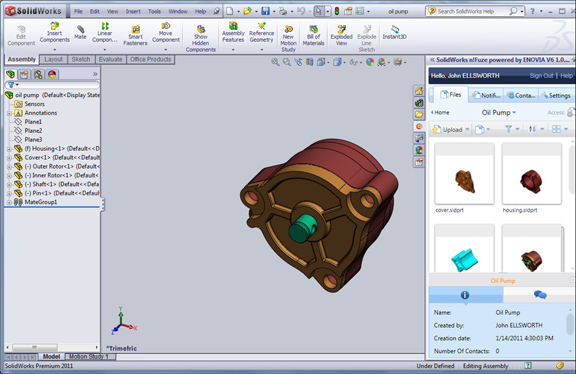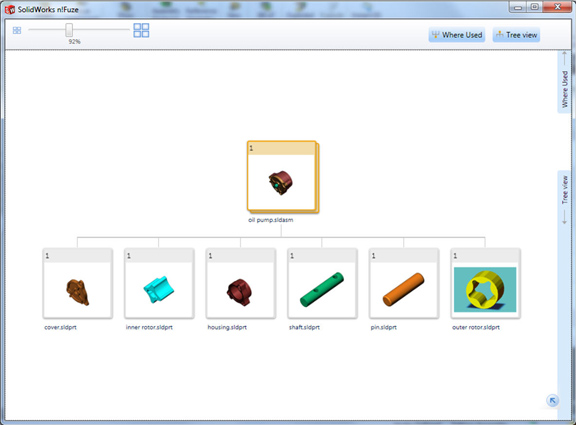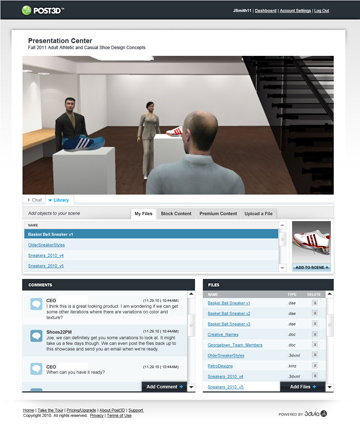Latest News
January 26, 2011


 For the title of this post, I’m borrowing a few words from the rousing battle cry of Henry V, as imagined by the immortal Anglo-Saxon bard Shakespeare. To defeat the French defense of Harfleur, Henry urged his troops to once again forge ahead:
For the title of this post, I’m borrowing a few words from the rousing battle cry of Henry V, as imagined by the immortal Anglo-Saxon bard Shakespeare. To defeat the French defense of Harfleur, Henry urged his troops to once again forge ahead:
Once more unto the breach, Dear Friends, once more;
The breach—or the gap that SolidWorks is attempting to close—is product data management, or PDM, for its littlest teams. Up to now, the company has been marching along in two columns: SolidWorks Workgroup PDM (for small teams or groups) and SolidWorks Enterprise PDM (for company-wide adoption). They’re both on-premise (or installed) bundles.
Now, at SolidWorks World 2011, it revealed its new assault plan, dubbed n!Fuze, to be deployed online. The name, as conceived and announced a year ago at SolidWorks World 2010, was SolidWorks Product Data Sharing. It was later renamed SolidWorks Connect. Eventually, it settled on n!Fuze.
Enter n!Fuze, Mini-PDM for SolidWorks
The lowercase n followed by an exclamation point “is a way to say ‘mini,’ ” said Bernard Charles, CEO of SolidWorks’ parent company Dassault Systemes. It also suggests web-enabled architecture. “For example, CATIA n!Share, as PLM express online,” explained Charles. “We want to use n to express that there is something specific to a product—it’s just online.”
The official description, as it appears in SolidWorks Blog, states, “It’s an improvement on traditional approaches for sharing files, such as email and FTP sites, because it integrates with your design tools to facilitate the way you work, uses familiar social networking concepts to engage with others, and avoids costly IT infrastructure and administration. It’s also quick and easy to get started with, simple to use, and accessible from anywhere.”
n!Fuze will most likely be licensed as a subscription, suitable for as small a team as two, with real-time chat and visualization features. It’s currently in closed Beta, so you may not be able to download and try it out yet (unless you’re one of the invited Beta testers). Once installed, it shows up as a tab in your SolidWorks pane, where you normally access your library, Help files, and other ancillary items. This gives you the ability to upload a file to a remote server, create a personal workspace, invite others to share the space with you, and make comments on files. In addition to desktop client, you can also access n!Fuze features from a smart phone or an iPad. (If you imagine a CAD plug-in that resembles an Instant Messenger window with some social functions, linked to a web-based FTP system like Dropbox, you might get some idea how it works.)
For what it’s worth, the product is powered by Dassault Systemes’ ENOVIA V6, but its interface and architecture are targeted at teams and organizations that are much smaller than typical ENOVIA buyers, so you would hardly recognize its ENOVIA roots in n!Fuze. So is it a PLM system for SolidWorks users (just as ENOVIA is the recommended PLM system for CATIA users)?
“I think we can bring new functions to SolidWorks users without scaring them with big acronyms,” observed Charles. “What we have to avoid is offering something too complex to someone who wants something simple.”

A Room with a 3D View
Along with data management, you may begin to see more 3D content creation tools, offered to SolidWorks users. The 3DVIA product line, for developing and producing 3D models that are not as detailed nor complex as mechanical CAD models created in SolidWorks, is essential to Charles’ vision of “lifelike experience.” He envisions a not-so-distant future where e-commerce is fueled by virtual storefronts, completed with interactive 3D replicas of real products (for example, a 3D model of a purse or handbag that can be rotated and opened).
To create lightweight 3D models of real-world products, you can use 3DVIA Shape, a free modeling application. To place your design in a virtual scene where your collaborators can explore or your potential customers may inspect them, you may use Post3D, the latest addition to the 3DVIA portfolio. Post3D is currently a technical preview, so its product managers are still working out the kinks. Unlike Flash animations, Post3D scenes take time to load in your browser window (need to install 3DVIA player to view it).
In its present incarnation, Post3D lets you pick your environment from a preloaded series of rooms, select your avatar from a number of available choices (not customizable currently), then start navigation the scene. Publishable (or uploadable) file formats include SolidWorks, IGES, STEP, COLLADA, and more (essentially, all formats supported by the 3DVIA content portal). Post3D has a build-in physics engine, not as sophisticated as the technology that powers high-end simulation software, but realistic enough to prevent your avatar from crashing through solid walls.
Similar uses of virtual space can be found among members of Second Life, a 3D virtual community created and hosted by Linden Research. The digital world has a thriving market place, complete with its own currency system, market place, and trade activities. But Second Life exists, for the most part, as an alternative to real life, an escape from your first—and primary—life.
Digital replicas and virtual showrooms may become acceptable alternatives where look is the most influential decision-making factor (for example, interior decoration, household appliances, and furniture). But they could be poor substitutes where touch, taste, and other senses are of greater concerns (for example, fabrics, fragrances, and musical instruments).
By now, the engineering rules and methods are well-established for digital manufacturing. The engineering of virtual experience, however, is new territory for engineers. Welcome to the new frontier!
Subscribe to our FREE magazine, FREE email newsletters or both!
Latest News
About the Author
Kenneth Wong is Digital Engineering’s resident blogger and senior editor. Email him at [email protected] or share your thoughts on this article at digitaleng.news/facebook.
Follow DERelated Topics






